

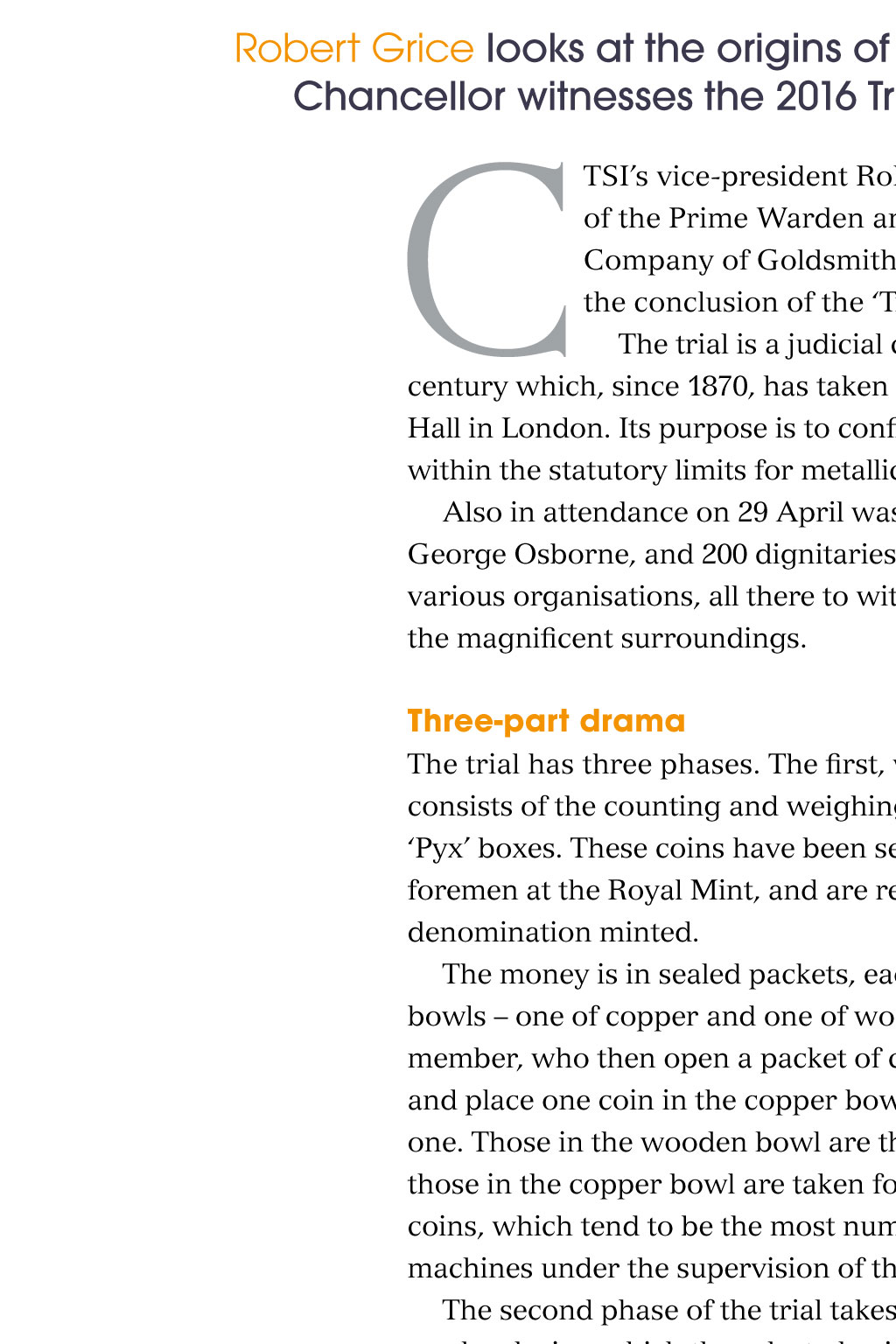
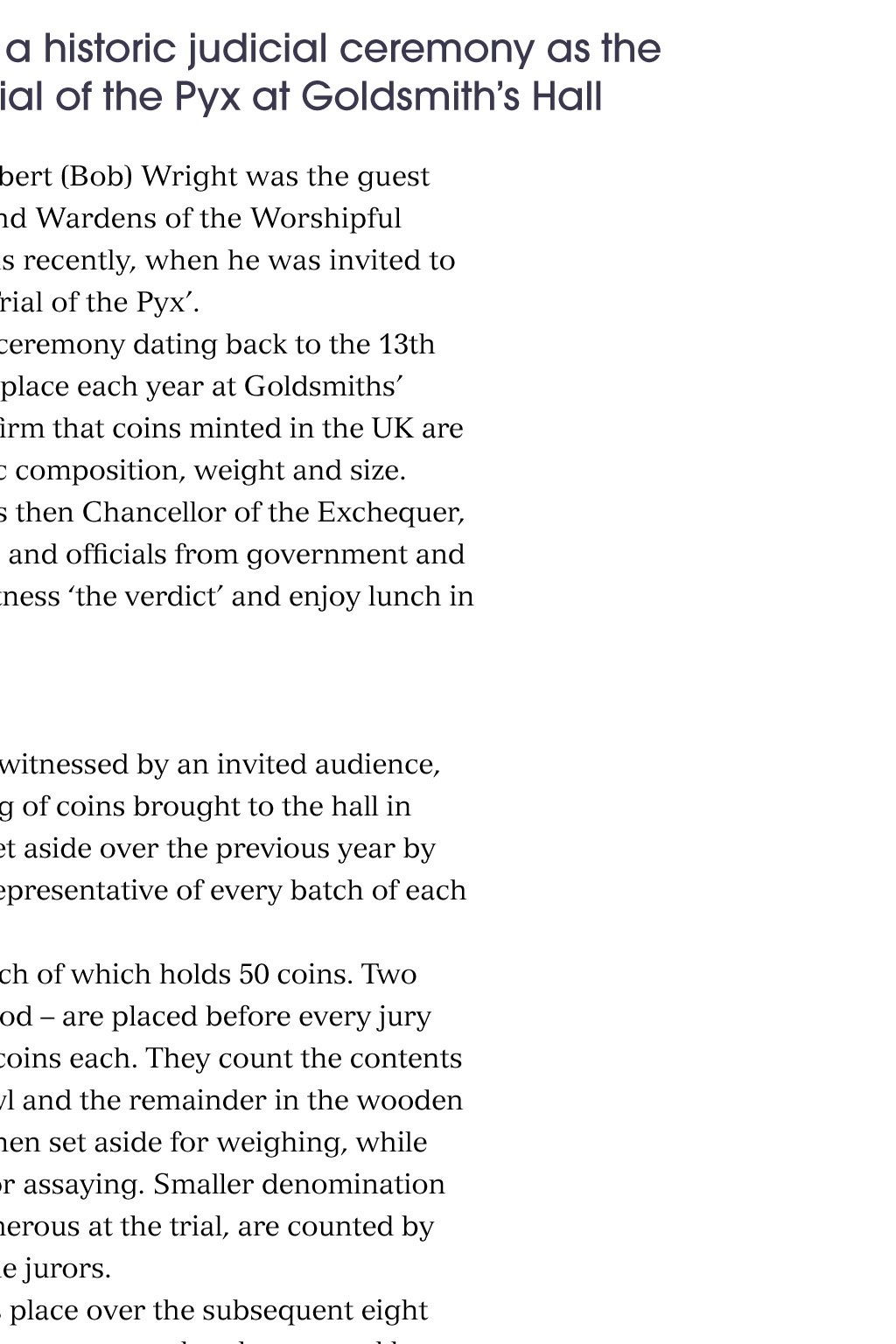

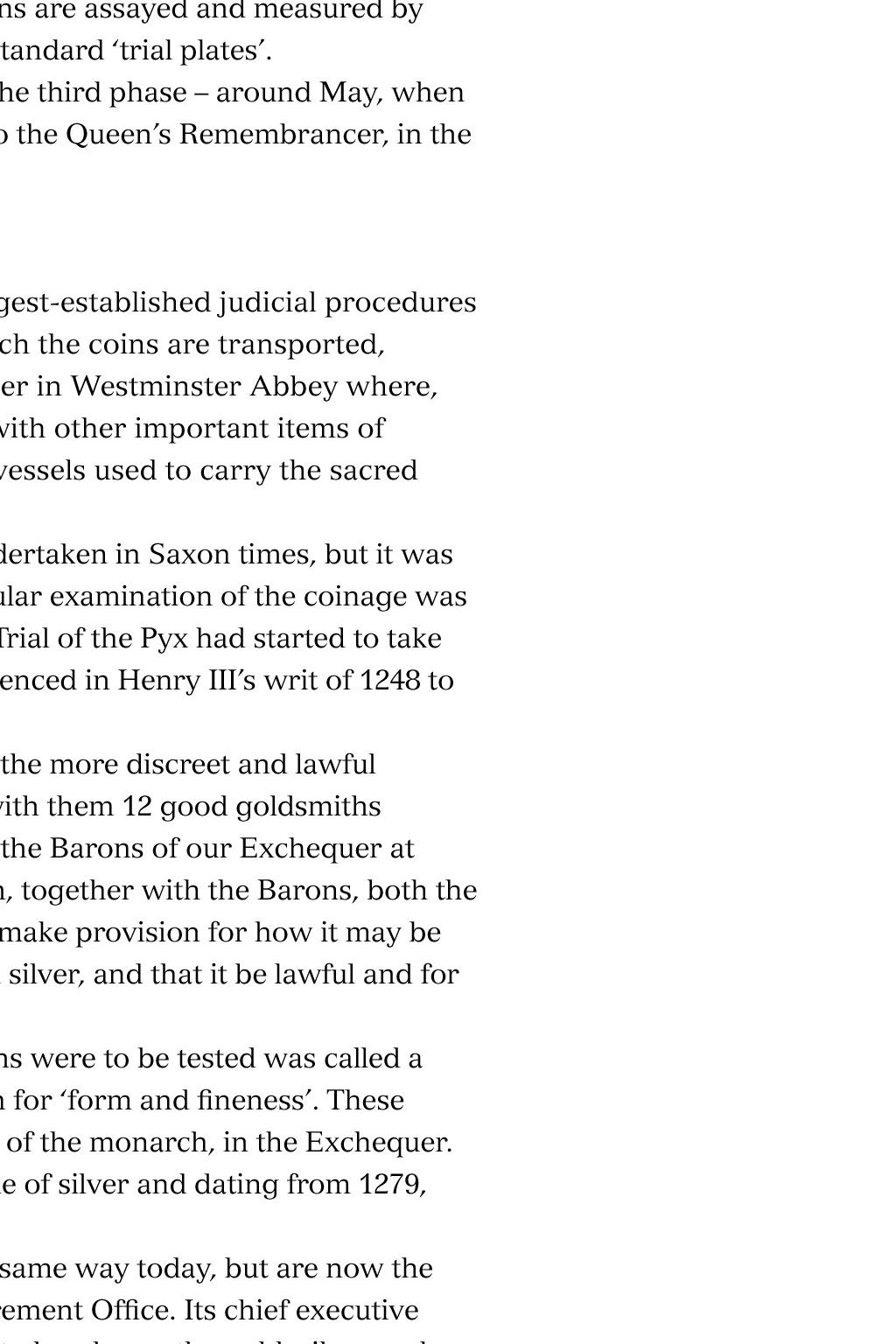

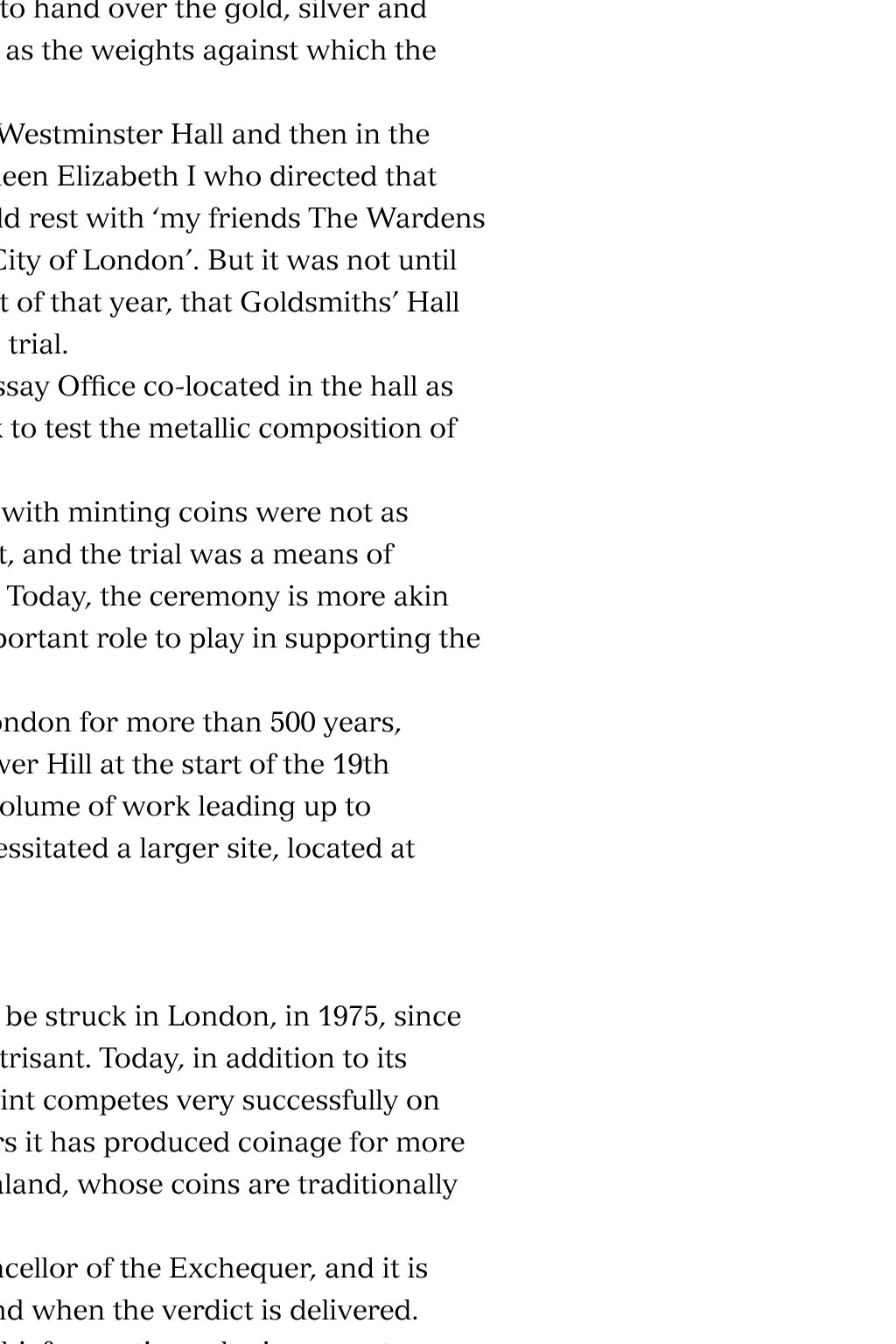
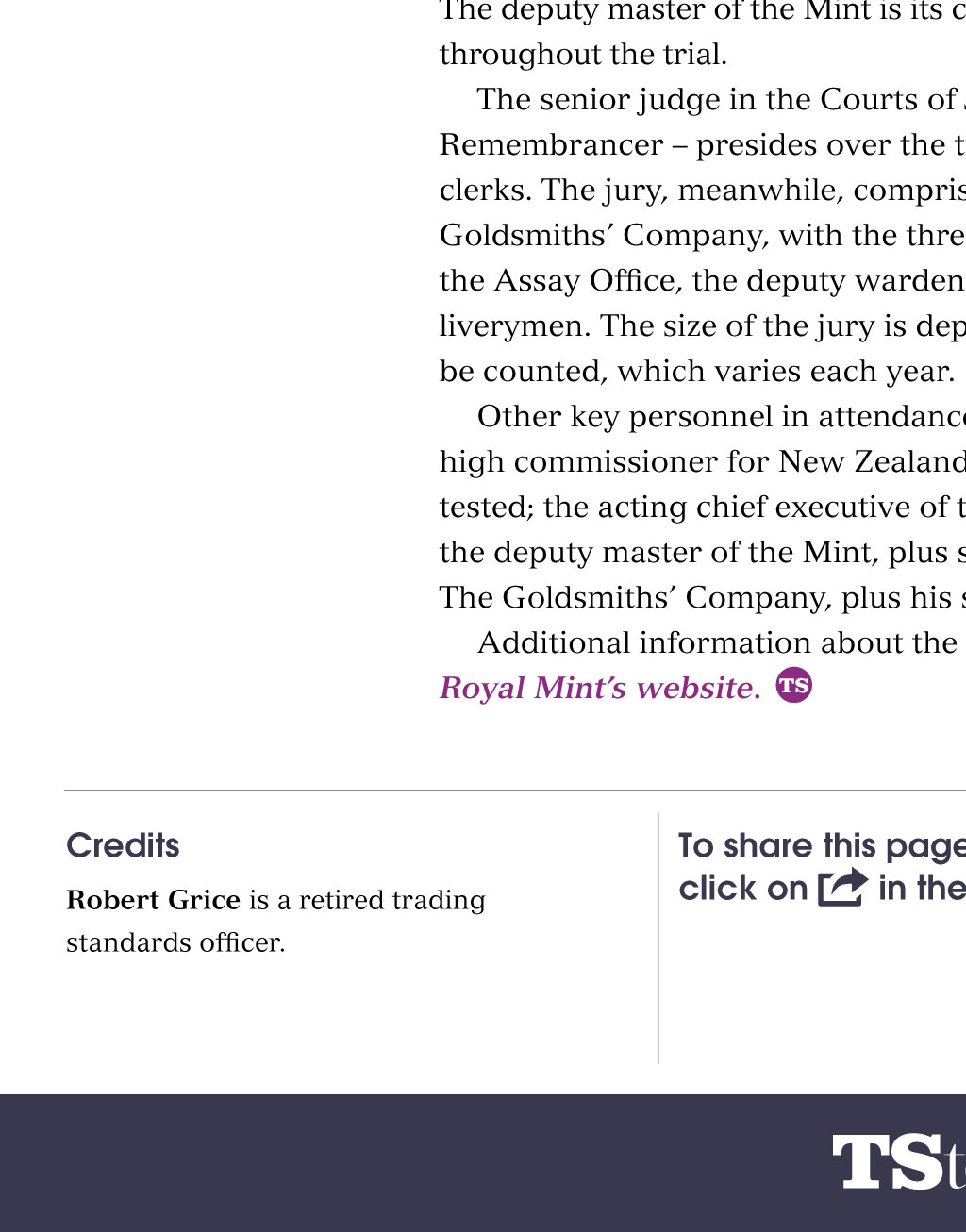
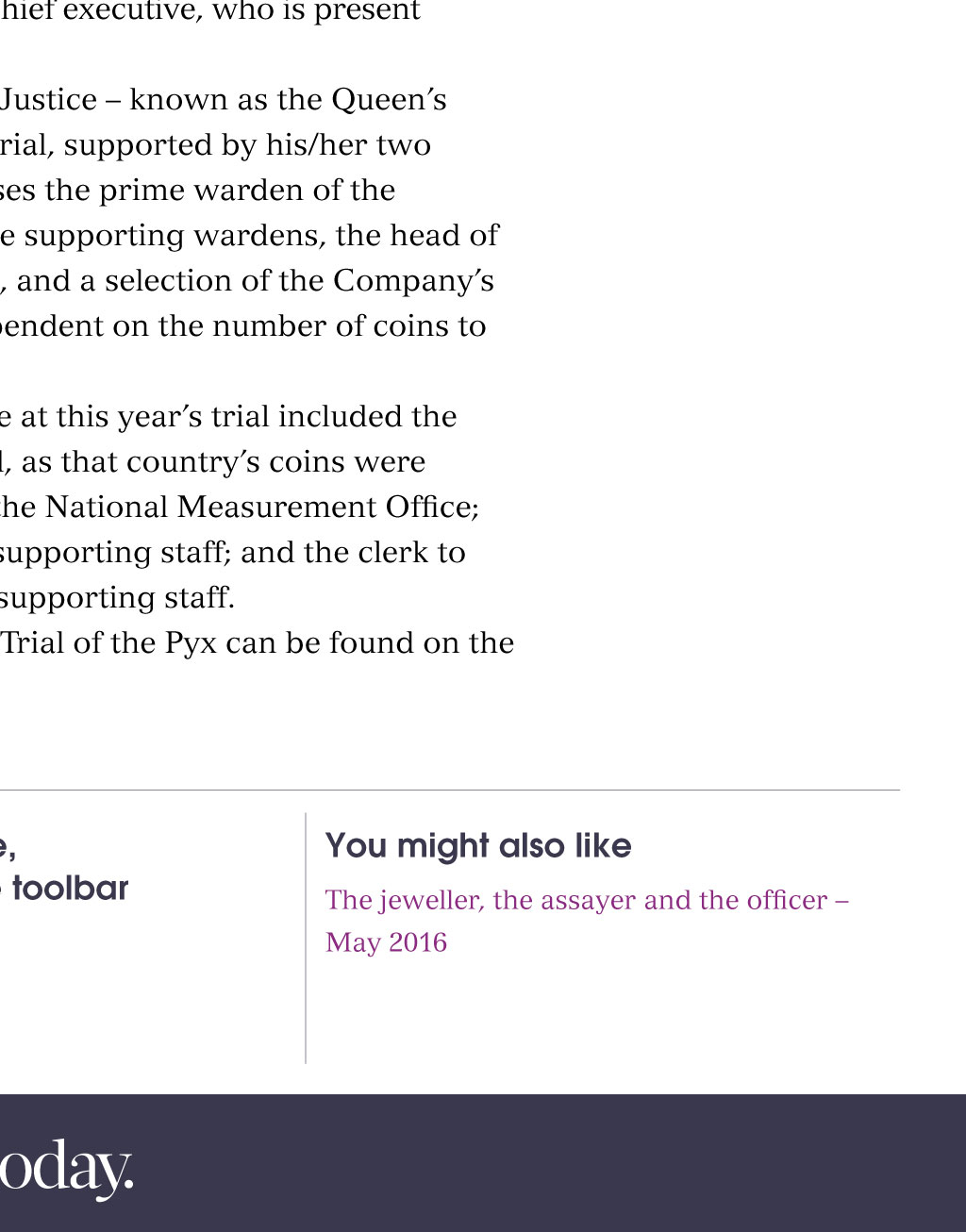











Trial of the Pyx In this feature the ceremony the verdict history Gold standard Robert Grice looks at the origins of a historic judicial ceremony as the Chancellor witnesses the 2016 Trial of the Pyx at Goldsmiths Hall C TSIs vice-president Robert (Bob) Wright was the guest of the Prime Warden and Wardens of the Worshipful Company of Goldsmiths recently, when he was invited to the conclusion of the Trial of the Pyx. The trial is a judicial ceremony dating back to the 13th century which, since 1870, has taken place each year at Goldsmiths Hall in London. Its purpose is to conrm that coins minted in the UK are within the statutory limits for metallic composition, weight and size. Also in attendance on 29 April was then Chancellor of the Exchequer, George Osborne, and 200 dignitaries and ofcials from government and various organisations, all there to witness the verdict and enjoy lunch in the magnicent surroundings. Three-part drama The trial has three phases. The rst, witnessed by an invited audience, consists of the counting and weighing of coins brought to the hall in Pyx boxes. These coins have been set aside over the previous year by foremen at the Royal Mint, and are representative of every batch of each denomination minted. The money is in sealed packets, each of which holds 50 coins. Two bowls one of copper and one of wood are placed before every jury member, who then open a packet of coins each. They count the contents and place one coin in the copper bowl and the remainder in the wooden one. Those in the wooden bowl are then set aside for weighing, while those in the copper bowl are taken for assaying. Smaller denomination coins, which tend to be the most numerous at the trial, are counted by machines under the supervision of the jurors. The second phase of the trial takes place over the subsequent eight weeks, during which the selected coins are assayed and measured by members of the Assay Ofce, using standard trial plates. Finally, the court is reconvened the third phase around May, when the verdict is delivered by the jury to the Queens Remembrancer, in the presence of the Chancellor. From London to Cardiff In Henry IIIs day, those minting coins were not as scrupulous, and the trial was a means of keeping a check on any wrongdoing The Trial of the Pyx is one of the longest-established judicial procedures in the UK. Pyx are the boxes in which the coins are transported, their name deriving from the chamber in Westminster Abbey where, historically, they were kept along with other important items of state and church, including the Pyx vessels used to carry the sacred bread at communion. Some form of coin testing was undertaken in Saxon times, but it was during the reign of Henry II that regular examination of the coinage was introduced. By the 13th century, the Trial of the Pyx had started to take the form that we know today, as evidenced in Henry IIIs writ of 1248 to the mayor and citizens of London. This entrusted them to elect 12 of the more discreet and lawful men of the City of London and join with them 12 good goldsmiths of the same city, who shall go before the Barons of our Exchequer at Westminster and examine, upon oath, together with the Barons, both the old and new money of our land, and make provision for how it may be bettered, and that it be made of good silver, and that it be lawful and for the good of the realm. The benchmark against which coins were to be tested was called a trial plate, which coins had to match for form and neness. These were kept under the personal charge of the monarch, in the Exchequer. The earliest surviving trial plate, made of silver and dating from 1279, is preserved at the Royal Mint. Trial plates are used in exactly the same way today, but are now the responsibility of the National Measurement Ofce. Its chief executive ofcer is present at the trial formally to hand over the gold, silver and cupronickel plates to the jury, as well as the weights against which the coins will be measured. Trials of the Pyx were held rst in Westminster Hall and then in the Exchequer at Westminster. It was Queen Elizabeth I who directed that responsibility for the ceremony should rest with my friends The Wardens of the Mystery of Goldsmiths of the City of London. But it was not until 1870, as laid down in the Coinage Act of that year, that Goldsmiths Hall became the established venue for the trial. This made good sense, with the Assay Ofce co-located in the hall as it is today. It is the Assay Ofces task to test the metallic composition of the coins. In Henry IIIs day, those entrusted with minting coins were not as scrupulous as the modern Royal Mint, and the trial was a means of keeping a check on any wrongdoing. Today, the ceremony is more akin to quality control, and still has an important role to play in supporting the Royal Mints enviable reputation. Formerly based in the Tower of London for more than 500 years, the Mint was relocated to nearby Tower Hill at the start of the 19th century. There it remained until the volume of work leading up to decimalisation in the early 1970s necessitated a larger site, located at Llantrisant, near Cardiff. Competing on the world stage A gold sovereign was the last coin to be struck in London, in 1975, since when all production has been at Llantrisant. Today, in addition to its national responsibilities, the Royal Mint competes very successfully on the international stage; in recent years it has produced coinage for more than 80 countries, including New Zealand, whose coins are traditionally included in the Trial of the Pyx. The master of the Mint is the Chancellor of the Exchequer, and it is customary for the Chancellor to attend when the verdict is delivered. The deputy master of the Mint is its chief executive, who is present throughout the trial. The senior judge in the Courts of Justice known as the Queens Remembrancer presides over the trial, supported by his/her two clerks. The jury, meanwhile, comprises the prime warden of the Goldsmiths Company, with the three supporting wardens, the head of the Assay Ofce, the deputy warden, and a selection of the Companys liverymen. The size of the jury is dependent on the number of coins to be counted, which varies each year. Other key personnel in attendance at this years trial included the high commissioner for New Zealand, as that countrys coins were tested; the acting chief executive of the National Measurement Ofce; the deputy master of the Mint, plus supporting staff; and the clerk to The Goldsmiths Company, plus his supporting staff. Additional information about the Trial of the Pyx can be found on the Royal Mints website. Credits Robert Grice is a retired trading standards ofcer. To share this page, in the toolbar click on You might also like The jeweller, the assayer and the ofcer May 2016